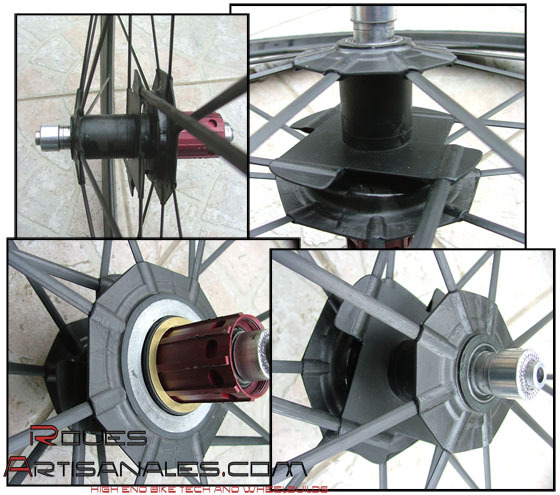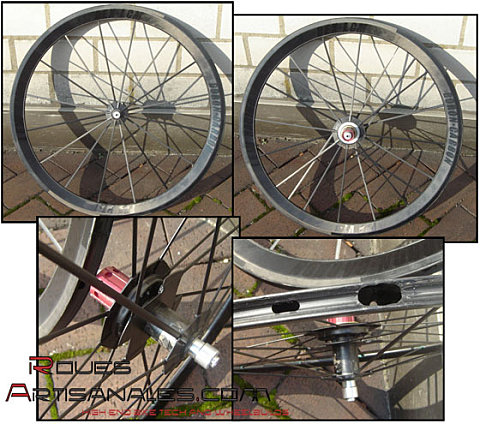|
For the story, we have been tested several high-end wheelsets earl in October for the December edition of the French magazine “L’Acheteur Cycliste”. The results were really surprising, at least for the Lew Racing Pro VT-1 wheelset that performed quite bad in
term of lateral stiffness. While the manufacturer claims a lot of stiffness, we found the wheels to be the flexiest, to high loads, on our lateral rigidity bench. The stiffness was so low
that the left side spokes of the wheel even bent under the load. We then thought those wheels were pure hype, especially considering we couldn’t try them because of the lack of
availability.
A few weeks after our test, TOUR magazine published their own test and revealed these very special wheels as a serious competitor to Lightweight and Mavic CCU.
We were torn between our test and their one… where was the truth?
In front of all our questions and disillusionments, Lew Racing finally managed to get us a set to test… on the road. Nils from Fairwheelbikes, who is their
official representative in Europe, arrived some days ago with his prototype set of the Pro VT-1 Tune version (840g) to test ride.
After short explanations on the wheels and the disassembling of the hubsets, we had a 2 hours ride together. It was quite fast and sportive, at least considering the season period and our lack of training. Average speed was 31/32km/h but the last 10 last kilometers
were about 40/45 km/h of average.
Inertia: a level never achieved in the past.
The most amazing thing about these wheels is perceptible from the first pedals stroke: the inertia is incredibly low and it reaches a level never achieved in
the past. The accelerations are very, very easy, and it’s really destabilizing during the first kilometers. Even the set of Lightweight 922g we tested some months ago were slightly more
resistant to accelerations. This weird phenomenon is caused by the outstanding weight of the rim which is only about 220g (270g as spare part). The drawback of this lightweight is that
the steering is very sensitive and it is harder than usually to keep a straight direction, unless you are used to ride them. Furthermore, the wind seems to affect more the steering, once
again because of the very lightweight rim and it’s depth (46mm).
Click to enlarge (955Kb)
Stiffness, adapted to the rider weight…
After a few hundred meters, the first road sign arrived at the top of a false uphill and, I couldn’t resist to sprint a first time with a big gear, to know
more about their stiffness. The wheels were simply everything but flexy and we couldn’t see the rim moving between the brake pads at all. This probably would have happened a little
differently during the summer when the shape is far better. But anyway, they felt plenty stiff and the result TOUR magasine published is closer to the reality than what we found.
Actually, what we found is very interesting too: we realized that under heavier loads, meaning heavier and stronger riders, those wheels won’t feel as stiff. That’s why Lew Racing offers
a Clydesdale version, which is 1050g, for riders over 85kg and up to 113kg (see here)
After a lot of questions to Paul Lew, president and engineer at Lew Racing and Lew Aerospace, it seems like these wheels are designed in a way never explored
by any other manufacturer in the past. On standard wheels, during accelerations, the rim tends to rub the brake pads because of the torque transfer: some spokes pull the rim and get more
tension, while the others push it while losing tension. Because of the difference in bracing angle between the two flanges, it creates a distorsion and the rim tends to move between the
brake pads. On this very special wheelset, the central flange, which is perfectly in the plane of the rim, transfers all the torque and prevents the torque transfer differences between
the exterior flanges. Thus, the wheel does not deform. This is what happen during accelerations.
In mountain, because of the low speed and the higher angle the bike does with the ground, the lateral load pushing the rim to the left and right is bigger so
the wheels might not feel as stiff. We hope to test another set of Pro VT-1 longer, and during the summer to know more…
Ride quality… with Dugast tires
The wheels we tested were mounted with Dugast tubulars, painted black to match the wheels color. Although ride quality is merely subjective, and a lot of
factors play a role, I found the wheels to be comfortable on rough roads. The vibrations didn’t arrive as usually to the handlebar and the saddle, they seemed more absorbed. Is this
caused by the very low frontal stiffness of the wheels? Does it come from the boron/carbon structure? Does it simply come from the tubular itself? It’s hard to say but anyway they were a
pleasure to ride.

Bearing resistance, hub mechanism in beta status?
The bearings used on these wheels feel special. Although there are standard high quality ceramic balls running into stainless steel races, they feel rough
contrary to most other hubs running with this kind of bearings. Rough doesn’t mean they are hard to turn. They are actually very smooth but you feel some kind of interferences while
rotating the axle. This is caused by the little amount of grease in the bearing to reduce its resistance and thus save some watts for more speed.

Click to enlarge (1118Kb)
The bearings are pressed into the carbon/boron hubs sheels, and the axles fit the bearings.
The hub width and play adjustment is realized thanks to shim washers and spacers. It works but the whole hubs’ mechanisms of these prototype still seemed in beta status and should receive
some important improvements. First, there were still play, between the brake pads, when the wheels are installed and the m² racer 38g quick releases closed. Though it was not perceptible on the road, it should not be present. Second, Lew Racing only advises at this time 3 kind of quick releases, that provide enough compression
strength, to avoid bearing play. It shouldn’t be the case if the wheels hubs were well designed. Third, the rear bearing resistance of the wheels we had in lab tests, was pretty high
under load and somewhat abnormal.
So, the compression strength have to be high to avoid play, but not too high to avoid power loss in the bearing… it really reduces our selection of quick releases.
Lately, Lew released the final version of those TUNE rear hub equipped wheelset. From what we know, the abnormal bearing resistance under load, the play between the rim, are solved.
Once again, we hope to be able to test the wheels soon.

Click to enlarge (969Kb)
Finish and visual appearance
The wheelset we originally had in test was one of the first produced, the finish was really poor, probably because of the difficulty to work with boron fibre.
The special shapes, particularly the one of the rear hub and the rim edges, doesn’t help either to make a clean finish.
In concrete terms, the hubs were not round, they seemed to have thickness differences, the rims missed material at several places, the green bonding glue was visible, etc.
While the version we tested on the road was still a prototype, it looked far better finished, Lew racing really made an effort on this side and seem to be able
to work the boron fibre much better. The hubs, as well as the rims, definitely looked more fair for a 4600/5000+ euros wheelset.
Rocket science for rocket performances!
|
Paul
Lew
http://www.ncet.org/tban/
|
The Lew Racing PRO VT-1 really pushed the envelope. Although they are very light with only 820/840g in TUNE version, they remain both stiff for a quite light rider (65kg) and aerodynamic.
The materials, the structure, the design are all breakthrough. We would like to say it’s the revolutionary wheelset but a lot of manufacturers tend to misuse this verb these days. We will
simply and obviously say, although it might be a bit strong, that those Pro VT-1 crush, or bury any other wheel currently on the market. However, although they are on the way to perfection,
the hubs still need to be improved, particularly in term of play and spacing.
Any chance to sell them at 2500 euros instead of 5000? I’ll buy 3 sets!
What’s good, what’s not as good?
|
+
|
–
|
|
Fastest accelerations
|
Very sensitive steering
|
|
Lightest « stock » wheels
|
Hub mechanism (on our proto set)
|
|
Stealth and class look
|
Rough finish
|
|
Breakthrough wheels
|
Availability
|
|
Customer service
|
Price
|
Previous Roues Artisanales articles:
– Lew Racing Clydesdale version
– Lew Racing VS
Lightweight Standard VS Mavic CCU
– Lew Racing 2008 rims
– Campagnolo 2008, Lew Racing, Colnago 2008
– Lew Racing wheels, why are they so attractive?
– Lew Racing, M5: the rims are unveiled
– Lew PRO VT-1: the new wheels
|






